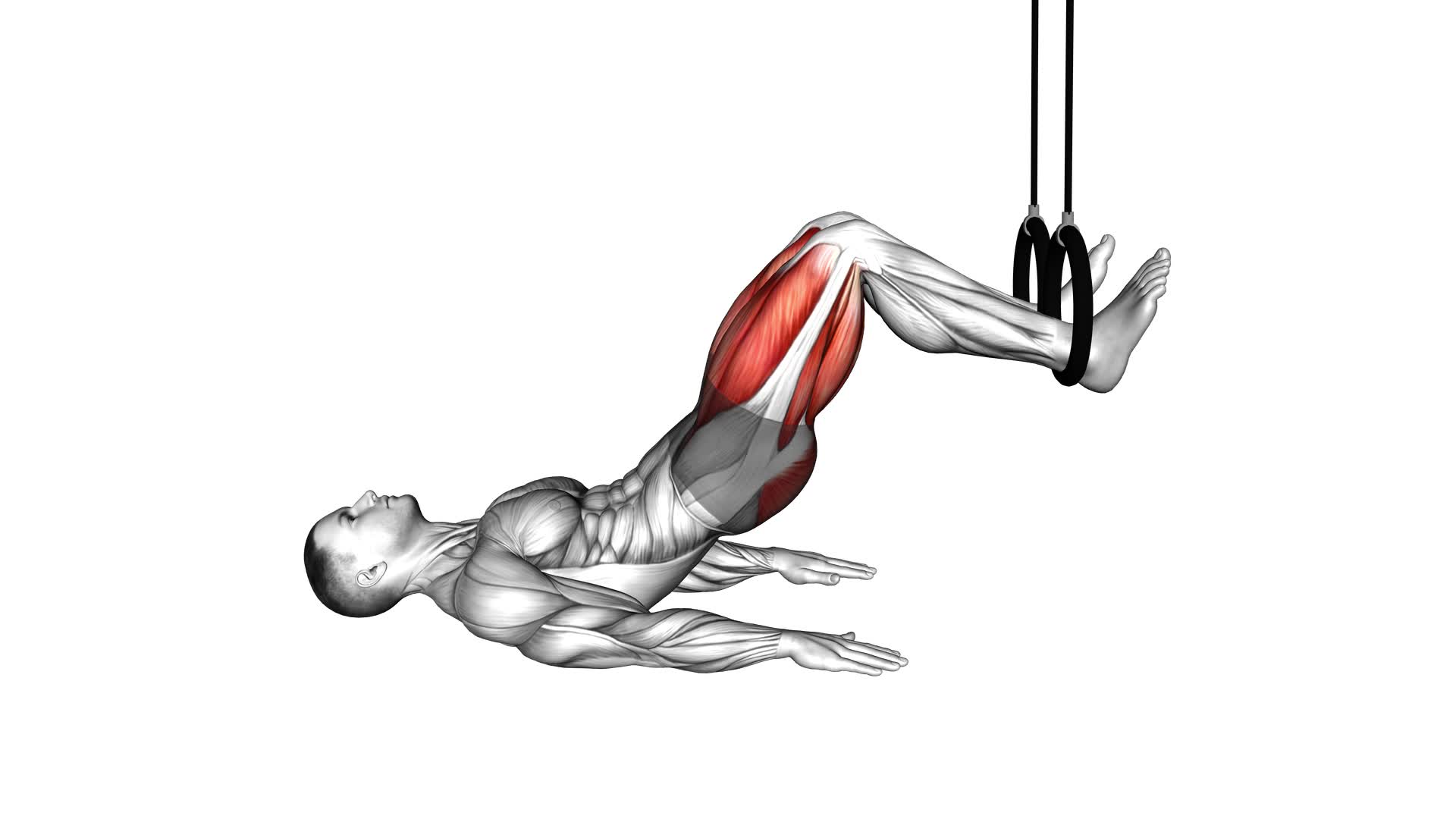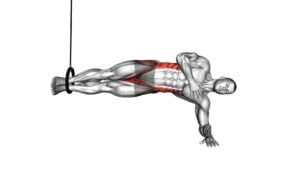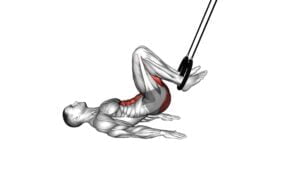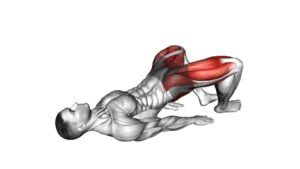Ring Hip Bridge (male) – Video Exercise Guide & Tips

Are you looking to strengthen your glutes and core?
Watch This Exercise Video
The Ring Hip Bridge exercise is just what you need!
In this video exercise guide, we'll show you how to properly perform the Ring Hip Bridge and give you tips to maximize its effectiveness.
Get ready to feel the burn and achieve a stronger, more toned lower body.
Let's dive in and start rocking those bridges!
Key Takeaways
- Activates glute muscles for hip stabilization and lower body strength
- Provides a unique challenge with the use of rings for increased engagement from core and glutes
- Targets hamstrings, quadriceps, and core muscles
- Enhances overall lower body strength and hip stability
Benefits of the Ring Hip Bridge
You can experience several benefits from performing the Ring Hip Bridge exercise. One of the key benefits is the importance of glute activation. The glute muscles, which include the gluteus maximus, medius, and minimus, are crucial for hip stabilization and overall lower body strength. By engaging these muscles during the Ring Hip Bridge, you can strengthen and activate your glutes more effectively than with traditional hip bridge exercises.
Compared to traditional hip bridge exercises, the Ring Hip Bridge offers a unique challenge. The use of rings adds instability, requiring more engagement from your core and glutes to maintain balance and control throughout the movement. This increased demand on your muscles can lead to greater strength gains and improved muscle activation.
In addition to glute activation and increased challenge, the Ring Hip Bridge also targets your hamstrings, quadriceps, and core muscles. By incorporating this exercise into your routine, you can enhance your overall lower body strength, improve hip stability, and develop a stronger core.
To properly set up and perform the Ring Hip Bridge exercise, you'll need a set of rings suspended at an appropriate height. By following proper setup and using the necessary equipment, you can maximize the benefits of this exercise and achieve optimal results.
Proper Setup and Equipment for the Exercise
To properly set up and perform the Ring Hip Bridge exercise, you'll need to gather the necessary equipment and ensure proper placement. Here are the key steps to follow:
- Rings: You'll need a set of gymnastic rings to perform the exercise. Make sure they're securely attached to an overhead anchor point that can support your body weight.
- Adjustment: Adjust the height of the rings so that they're approximately waist height when you're standing. This will allow you to easily transition into the starting position.
- Foot Placement: Stand facing the rings and position your feet hip-width apart. The rings should be directly in front of you and within reach of your hands.
- Grip: Take hold of the rings with an overhand grip, palms facing down. Your hands should be slightly wider than shoulder-width apart.
Remember to maintain proper form throughout the exercise. Engage your core, squeeze your glutes, and keep your body in a straight line from your head to your heels.
Step-by-Step Guide to Perform the Ring Hip Bridge
To perform the Ring Hip Bridge, begin by standing facing the rings with your feet hip-width apart and the rings directly in front of you. Grab the rings with an overhand grip, ensuring that your arms are fully extended. Engage your core muscles and keep your body in a straight line from your head to your heels.
Next, lift your hips off the ground while maintaining the straight line position. As you lift your hips, focus on squeezing your glutes and engaging your hamstrings. Hold this position for a few seconds before slowly lowering your hips back down to the starting position. Repeat this movement for the desired number of repetitions.
As you progress with the Ring Hip Bridge, you can try different variations to increase the difficulty. One variation is to elevate your feet by placing them on a stable surface, such as a bench or a step. This will increase the range of motion and intensify the exercise. Another variation is to perform the Ring Hip Bridge with one leg, which challenges your stability and engages each glute individually.
Common Mistakes to Avoid During the Exercise
When performing the Ring Hip Bridge, it's important to be mindful of common mistakes to ensure proper form and maximize the effectiveness of the exercise. Here are some common mistakes to avoid:
- Raising your hips too high: It's essential to maintain a straight line from your knees to your shoulders. Avoid hyperextending your lower back by lifting your hips too high. This can put unnecessary strain on your spine and decrease the effectiveness of the exercise.
- Allowing your knees to cave in: Keep your knees in line with your hips and ankles throughout the movement. Allowing your knees to collapse inward can lead to instability and put stress on your joints. Engage your glutes and focus on pushing your knees outwards.
- Neglecting to engage your core: Your core plays a crucial role in stabilizing your body during the Ring Hip Bridge. Ensure that you're actively engaging your core muscles by drawing your belly button in towards your spine. This will help maintain proper alignment and prevent excessive arching of the lower back.
- Using momentum: Avoid using momentum to lift your hips. Instead, focus on using your glutes to drive the movement. This will ensure that you're targeting the correct muscles and getting the most out of the exercise.
Tips to Maximize the Effectiveness of the Ring Hip Bridge
To make the most out of the Ring Hip Bridge exercise, focus on proper positioning and activating the correct muscles. This will help maximize the effectiveness of the workout and ensure that you're targeting the right areas.
One tip to enhance the Ring Hip Bridge is to explore different variations and modifications. By incorporating variations into your routine, you can challenge your muscles in new ways and prevent your workout from becoming stagnant. Some variations you can try include single-leg hip bridges, elevated hip bridges, or adding resistance bands for extra resistance.
Additionally, you can modify the exercise by adjusting the height of the rings or the position of your feet. This allows you to target different muscle groups and tailor the exercise to your specific needs and goals.
Remember to listen to your body and start with modifications that are suitable for your current fitness level. By incorporating variations and modifications into your Ring Hip Bridge routine, you can continually challenge your muscles and improve your overall strength and stability.
Frequently Asked Questions
Is the Ring Hip Bridge Suitable for Beginners or Is It More Suitable for Experienced Individuals?
The ring hip bridge is suitable for both beginners and experienced individuals. It offers benefits for improving posture.
Whether you're just starting out or have been exercising for a while, this exercise can help strengthen your glutes, hamstrings, and core muscles. It also activates your hip stabilizers, promoting better hip mobility and stability.
Incorporating the ring hip bridge into your workout routine can be beneficial for individuals at any fitness level.
Can the Ring Hip Bridge Exercise Help With Improving Posture?
The ring hip bridge exercise can definitely help improve your posture. By incorporating this exercise into your full body workout routine, you'll experience several benefits.
Not only will it strengthen your glutes, hamstrings, and core, but it will also activate your posterior chain muscles, promoting better alignment and posture.
To perform the ring hip bridge effectively, start by lying on your back, placing your feet on the rings, and lifting your hips off the ground. Be sure to engage your glutes and maintain a straight line from your shoulders to your knees.
Are There Any Alternative Exercises That Can Be Done in Conjunction With the Ring Hip Bridge to Target the Same Muscle Groups?
To target the same muscle groups as the ring hip bridge, there are several alternative exercises you can do.
One option is the glute bridge, which involves lying on your back with your knees bent and lifting your hips off the ground.
Another exercise is the single-leg hip thrust, where you perform a hip bridge but with one leg extended in the air.
These exercises can help you strengthen and tone your glutes, hamstrings, and lower back.
How Often Should the Ring Hip Bridge Exercise Be Performed for Optimal Results?
For optimal results, it's important to know how often the ring hip bridge exercise should be performed.
This exercise is suitable for both beginners and experienced individuals. It targets multiple muscle groups, including the glutes, hamstrings, and core.
To maximize its benefits, aim to perform the ring hip bridge exercise 2-3 times per week.
However, it's always recommended to consult with a fitness professional to create a personalized workout plan based on your fitness level and goals.
Are There Any Modifications or Variations of the Ring Hip Bridge That Can Be Done to Make the Exercise More Challenging or Target Different Muscle Groups?
To make the ring hip bridge exercise more challenging or target different muscle groups, there are a few modifications you can try.
You can perform single-leg ring hip bridges to increase the difficulty and engage your glutes and hamstrings more intensely.
Another variation is the ring hip bridge march, where you lift one leg at a time while maintaining the bridge position. This targets your core and hip flexors in addition to the glutes and hamstrings.
Conclusion
In conclusion, the Ring Hip Bridge is a beneficial exercise for strengthening the lower body and core muscles.
By following the proper setup and equipment guidelines, and using the step-by-step guide, you can perform this exercise effectively.
Avoiding common mistakes and implementing the provided tips will help maximize the effectiveness of the Ring Hip Bridge.
Incorporate this exercise into your fitness routine for improved strength and stability.

Author
Years ago, the spark of my life’s passion ignited in my mind the moment I stepped into the local gym for the first time. The inaugural bead of perspiration, the initial endeavor, the very first surge of endorphins, and a sense of pride that washed over me post-workout marked the beginning of my deep-seated interest in strength sports, fitness, and sports nutrition. This very curiosity blossomed rapidly into a profound fascination, propelling me to earn a Master’s degree in Physical Education from the Academy of Physical Education in Krakow, followed by a Sports Manager diploma from the Jagiellonian University. My journey of growth led me to gain more specialized qualifications, such as being a certified personal trainer with a focus on sports dietetics, a lifeguard, and an instructor for wellness and corrective gymnastics. Theoretical knowledge paired seamlessly with practical experience, reinforcing my belief that the transformation of individuals under my guidance was also a reflection of my personal growth. This belief holds true even today. Each day, I strive to push the boundaries and explore new realms. These realms gently elevate me to greater heights. The unique combination of passion for my field and the continuous quest for growth fuels my drive to break new ground.







